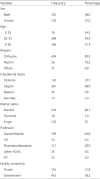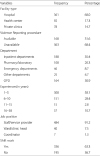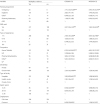2. Liu H, et al. Extent, nature, and risk factors of workplace violence in public tertiary hospitals in China: a cross-sectional survey. Int J Environ Res Public Health. 2015; 12(6):6801–6817. DOI:
10.3390/ijerph120606801. PMID:
26086703.

5. Yang L-Q, et al. Psychosocial precursors and physical consequences of workplace violence towards nurses: a longitudinal examination with naturally occurring groups in hospital settings. Int J Nurs Stud. 2012; 49(9):1091–1102. DOI:
10.1016/j.ijnurstu.2012.03.006. PMID:
22546849.

6. Speroni KG, et al. Incidence and cost of nurse workplace violence perpetrated by hospital patients or patient visitors. J Emerg Nurs. 2014; 40(3):218–228. DOI:
10.1016/j.jen.2013.05.014. PMID:
24054728.

7. Semahegn A, Mengistie B. Domestic violence against women and associated factors in Ethiopia; systematic review. Reprod Health. 2015; 12:1–12. DOI:
10.1186/s12978-015-0072-1. PMID:
25561377.

8. Newman CJ, et al. Workplace violence and gender discrimination in Rwanda's health workforce: increasing safety and gender equality. Hum Resour Health. 2011; 9:1–13. DOI:
10.1186/1478-4491-9-19. PMID:
21223546.

9. Lanctôt N, Guay S. The aftermath of workplace violence among healthcare workers: a systematic literature review of the consequences. Aggress Violent Behav. 2014; 19(5):492–501. DOI:
10.1016/j.avb.2014.07.010.

10. Heponiemi T, et al. The prospective effects of workplace violence on physicians’ job satisfaction and turnover intentions: the buffering effect of job control. BMC Health Serv Res. 2014; 14(1):1–8. DOI:
10.1186/1472-6963-14-19. PMID:
24382312.

12. Lin WQ, et al. Workplace violence and job performance among community healthcare Workers in China: the mediator role of quality of life. Int J Environ Res Public Health. 2015; 12(11):14872–14886. DOI:
10.3390/ijerph121114872. PMID:
26610538.
13. Fute M, et al. High prevalence of workplace violence among nurses working at public health facilities in southern Ethiopia. BMC Nurs. 2015; 14:1–5. DOI:
10.1186/s12912-015-0062-1. PMID:
25598706.

15. Sripichyakan, K., P. Thungpunkum, and B. Supavititpatana, Workplace violence in the health sector. 2001.
16. Aytac S, Dursun S, Akalp G. Workplace violence and effects on turnover intention and job commitment: a pilot study among healthcare workers in Turkey. Eur Sci J, ESJ. 2016; 12(10):458–465.
17. Abodunrin O, et al. Prevalence and forms of violence against health care professionals in a South-Western city, Nigeria. Sky J Med Med Sci. 2014; 2(8):67–72.
18. Jira C. Assessment of the prevalence and predictors of workplace violence against nurses working in referral hospitals of Oromia regional state, Ethiopia. JIMS8M: J Indian Manag Strateg. 2015; 20(1):61–64.
19. Magnavita N, Heponiemi T. Violence towards health care workers in a public health Care Facility in Italy: a repeated cross-sectional study. BMC Health Serv Res. 2012; 12(1):1. DOI:
10.1186/1472-6963-12-108. PMID:
22214259.

20. Pinar T, et al. Workplace violence in the health sector in Turkey: a National Study. J Interpers Violence. 2015:1–21.
21. Muzembo BA, et al. Workplace violence towards Congolese health care workers: a survey of 436 healthcare facilities in Katanga province, Democratic Republic of Congo. J Occup Health. 2015; 57(1):69–80. DOI:
10.1539/joh.14-0111-OA. PMID:
25476862.

22. Algwaiz WM, Alghanim SA. Violence exposure among health care professionals in Saudi public hospitals. A preliminary investigation. Saudi Med J. 2012; 33(1):76–82. PMID:
22273653.
23. Palácios, M., et al., Workplace violence in the health sector. Country case study-Brazil. ILO, ICN, WHO and PSI joint Programme on workplace violence, 2003.
24. Fisekovic MB, et al. Does workplace violence exist in primary health care? Evidence from Serbia. Eur J Pub Health. 2015; 25(4):693–698. DOI:
10.1093/eurpub/cku247. PMID:
25644138.

25. El-Gilany AH, El-Wehady A, Amr M. Violence against primary health care workers in Al-Hassa, Saudi Arabia. J Interpers Violence. 2010; 25(4):716–734. DOI:
10.1177/0886260509334395. PMID:
19494243.









 Citation
Citation Print
Print


 XML Download
XML Download